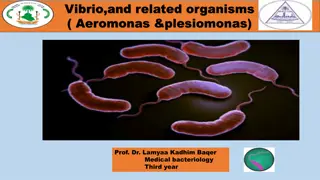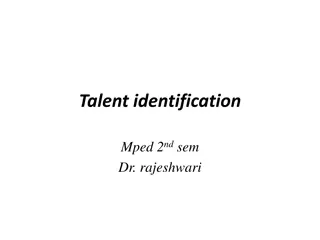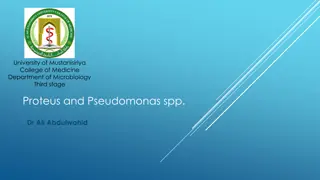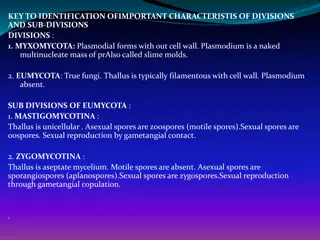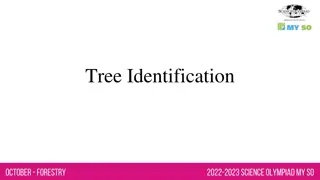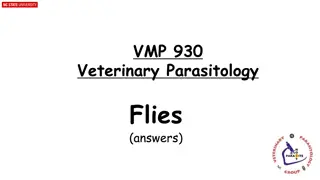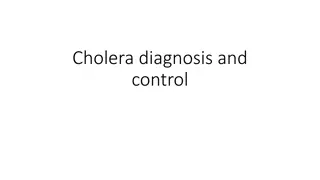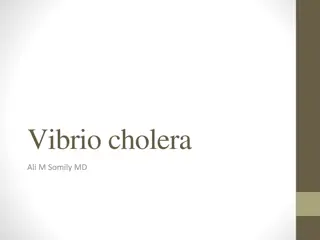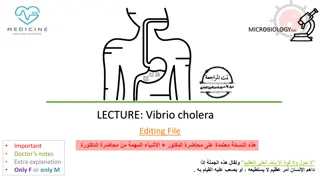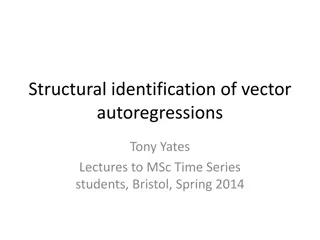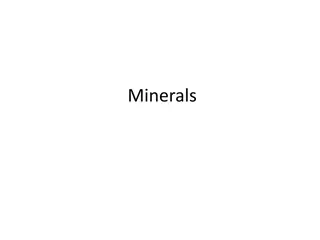Overview of Vibrio cholerae: Characteristics and Identification
Vibrio cholerae is a gram-negative, curved rod bacterium known for causing cholera. Its distinctive features include polar flagellum motility, oxidase-positive nature, and resistance to inhibitory substances. Various culture media are used for its isolation and growth, such as transport, routine, and enrichment media. The TCBS medium is commonly employed for Vibrio cholerae isolation. The Cholera Red Reaction test helps in identification through the production of nitroso-indole. Understanding the characteristics and identification of Vibrio cholerae is crucial for managing outbreaks and preventing the spread of cholera.
Download Presentation

Please find below an Image/Link to download the presentation.
The content on the website is provided AS IS for your information and personal use only. It may not be sold, licensed, or shared on other websites without obtaining consent from the author. Download presentation by click this link. If you encounter any issues during the download, it is possible that the publisher has removed the file from their server.
E N D
Presentation Transcript
Vibrio cholerae The name Vibrio is derived from the characteristic vibratory motility. In fact Koch initially named his isolates as the comma bacillus. The family vibirionaceace include three genera : Vibrio, Aeromonas and Plesiomonas. Vibrio species are essentially intestinal pathogens, whereas the Aeromonas and Plesiomonas have been isolated from variety of other sources
such as blood, spinal fluid, faeces and urine. There distinctive character of motility by polar flagellum, rather than peritrichate flagella, oxidase (+) character has excluded vibrio's from enterobacteriaceae. The genus Vibrio contains some of the most important intestinal pathogens of man including the case of epidemic Asiatic cholera, Vibrio cholerae another intestinal pathogen Vibrio parahaemolyticus is reading case of diarrhea in Japan. Other vibrio's Known as non agglutinable vibrio and non cholera can causes diarrhea in man. Vibrio cholerae Short curved rods, gram negative, non sporing, non capsulated , comma shaped. The degree of curvature varies from a short comma shaped from to definite spirals with man or two turns giving either a C or S shape. Short spiral or S shape is due to two organisms lying end to end. Catalase (+), oxidase (+). Cultural characters: The bacteria is strongly aerobic and very scanty growth occurs an aerobically. An alkaline reaction is essential for good growth, it can tolerate alkaline conditions to pH9.5. sufficiently high to inhibit the growth of most other pathogenic organisms. The relative resistance of cholera vibrio to inhibitory substances such as bile salts, bismuth sulphite, tellurite and high alkalinity is used to advantage in the preparation of variety of selective media. Growth is inhibited by 7% NaCl. Sensitive to acid pH, as pH6 or less will sterilize cultures.
The culture media may be described as under: 1- transport media 2- Routine culture media 3- enrichment media Transport media: 20 gm NaCl + 5gm peptone , water 1000ml. PH 8.6-8.8. to 10-12 ml of the medium in screw capped bottle about 3ml of fasces is added and mixed. Vibrio do not multiply in this medium but remain viable for several weeks . Routine culture media: 1-Nutrient agar 2- Blood agar 3- MacConkey's agar: the vibrios produce pale, non lactose fermenting colonies which may become pinkish when older. Enrichment media: 1- Alkaline peptone water 2- Alkaline bile salt agar 3- Mansur's medium ( Gelatin, taurocholate, trypticase, tellurite agar ) ( GTTTA) pH 8.5-9.2. 4- Thiosulphate, citrate, bile salt, sucrose medium ( TCBS ). It is enrichment medium and is very widely used for isolation and growth of Vib. Cholerae. The colonies are large, yellowish due to sucrose fermentation. .
Cholera red reaction: This reaction performed by adding pure sulphuric acid drop to a 24h. peptone water culture of the bacteria. If positive a red coloration appears almost immediately. This reaction depend on the production of indole and nitrites and the reddish color develops due to the forming of nitroso-indole.
Classification: Cholera and cholera like vibrios where divided in to 8 subgroups based on the O- antigens. Serogroup O type 1 ( 0:1 ) contain, the biotypes cholera and EL Tor. Based on differences in minor O- antigens, three variants of a single serotype, named Ogawa, Inaba and Hikojima which in this subgroup 1 have been defined. There antigenic formulae are noted generally given as follows: O-serotypes of cholera vibrio Serotype O-antigens Ogawa AB Inaba AC Hikojima ABC For practical purpose it is convenient to classify the vibrios under three heading: 1- Classical Vibrio cholerae 2- EL Tor vibrio's 3- NAG vibrio's ( non agglutinable ) or non cholera vibrio (NCV). Cross reaction between Brucella and Vibrio cholerae is caused by a specific O-antigen shared by both and this has given rise to positive Brucella agglutination tests in persons who are not infected with Brucella but have been immunized with cholera vaccine.
The toxin action for V. cholerae: A heat labile antigen exotoxin ( Choleragen ) can cause the out pouring of more fluid in which the vibrio's multiply and form toxin. This toxin also has permeability effect and can be converted to toxoid.
Differential characters of V. cholerae and EL Tor vibrio reaction Type Sensitivity to phage IV Polymyxin sensitivity Chicken RBC.s agglutination Vp reaction Soluble haemolysin - - Classical V. cholerae + + - + + - - + El Tor vibrio Toxins: The following toxins and enzymes have been described: 1- Enterotoxin 2- Vascular permeability factor 3- Sodium pump inhibition 4- Cytotoxin 5- Haemolysin 6- Mucinase.


